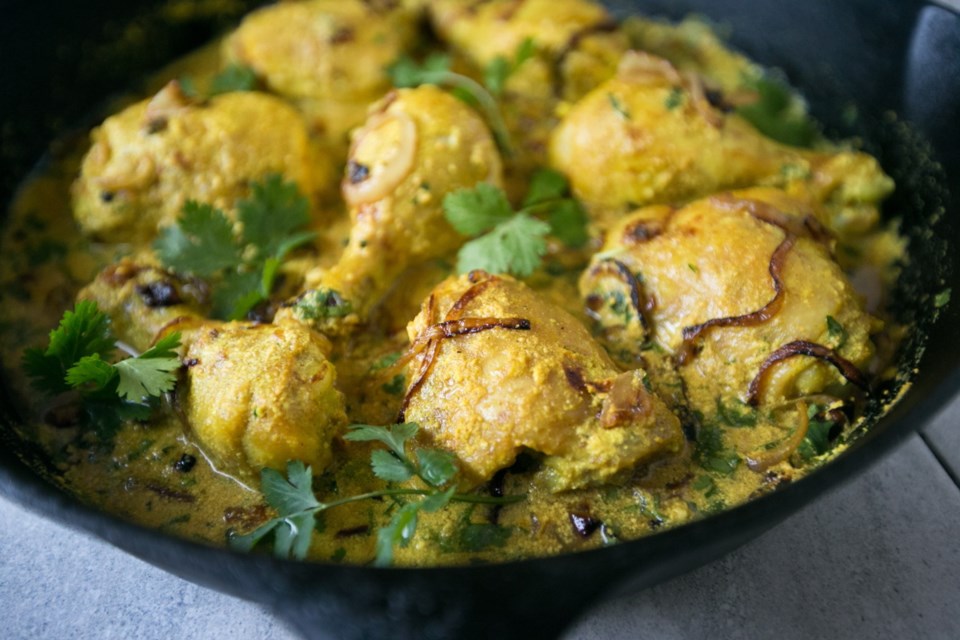 Dear Eric: I wonder if you have a recipe for chicken korma. I must admit to never hearing about it until at work the other day when someone had some for their lunch.
Dear Eric: I wonder if you have a recipe for chicken korma. I must admit to never hearing about it until at work the other day when someone had some for their lunch.
Diane
According to Charmaine Solomon’s fact-filled book Encyclopedia of Asian Food, korma, also spelled kurmah or quorma, indicates a braised dish. Solomon says korma is a Mughal-influenced dish that became popular throughout India. As Diane discovered, it also became popular in places around the world where Indian food is enjoyed, including Canada.
The meat most often braised in the first kormas was cook-me-for-a-while tough mutton, a mature sheep.
In modern recipes, though, quicker-cooking, younger lamb or chicken are the meats most often braised “korma-style” in a yogurt-based sauce that’s rich and fragrant with spice.
Some of the spices used in korma include cinnamon, coriander, cardamom and cloves. In Solomon’s book, she adds that korma would be authentic without even a touch of spicy-hot chilies.
Famed Indian cook Madhur Jaffrey seconds that motion in her cookbook A Taste of India. In the introduction to her lamb korma recipe, which has an option to use chicken instead of lamb, she says this dish is not the slightest bit hot and is not meant to be.
She is referring to Kashmiri-style dhaniwal korma, which is made by simmering the meat first, and then braising it in a yogurt-based sauce rich with spices and other tastes, such as garlic, fresh cilantro and richly browned onions.
With Solomon’s definition of korma as simply a braised dish, I wasn’t surprised to find many other variations of korma, some that do use spicy chili peppers.
That said, I really enjoy Indian-style dishes that are rich with spice, but are not spicy hot, as it’s easier to identify and enjoy every subtle taste when your mouth is not on fire.
So I came up with a variation of Jaffrey’s recipe for Diane to try.
The variations I made to her recipe were to simmer the chicken pieces in chicken broth first, rather than water, which gave it a deeper flavour.
I also used ground cardamom instead of whole cardamom pods in the yogurt sauce, simply because that’s what I had on hand. I also added a pinch of crumbled saffron threads, a colour- and flavour-enhancing ingredient added to other korma recipes that I read. My last variation was to add a tiny bit of cornstarch to the sauce, which gave it a smoother texture.
The chicken tasted rich and wonderful, a lovely Sunday supper. Serve it with steamed basmati rice and a green vegetable, such as wilted kale, chard or spinach.
Dhaniwal-style Chicken Korma
This Kashmiri-style chicken korma sees pieces of the bird braised in a yogurt sauce infused with aromatic spices, including cinnamon, cloves, cardamom and peppercorns.
Preparation: 25 minutes
Cooking time: About 65 minutes
Makes: Four servings
2 1/2 cups chicken broth or stock
1⁄2 tsp ground turmeric
4 chicken thighs
4 chicken drumsticks
• pinch or two salt
2 medium onions, each halved and thinly sliced into half rings
3 Tbsp vegetable oil
5 black peppercorns
4 whole cloves
1 cinnamon stick, broken into three pieces
1/2 tsp ground cardamom
1 (650 gram) tub plain natural yogurt (see Note)
3 to 4 large garlic cloves, minced
• pinch saffron threads, crumbled (optional)
1 tsp cornstarch dissolved in 1 Tbsp water
1/2 cup chopped fresh cilantro
• coarsely cracked black pepper, to taste
• cilantro sprigs
Combine the broth (or stock), turmeric and salt in an eight- or nine-inch wide pot.
Set the chicken in the pot, pushing it down to submerge it in the broth. Set the pot over medium-high heat. Bring to a boil, and then reduce the heat until the stock gently simmers.
Simmer the chicken, partially covered (don’t completely cover, as steam needs to escape), for 20 to 25 minutes, or until chicken is just cooked through. Lift the chicken out of the pot and set on a plate. Reserve the broth.
Place the oil in a large skillet or wide pot (mine was 12 inches wide) set over medium-high heat. Add the onions and cook and stir until richly brown and almost crispy, about 13 to 14 minutes. Line a second plate with paper towel, and then spoon the onions on it to drain.
Add the peppercorns, cloves, cinnamon and cardamom to the skillet and cook and stir 30 seconds. Add the yogurt, garlic and saffron, if using. Cook, stirring constantly, until mixture has reduced to a thick sauce, about 10 minutes. (The yogurt might look separated at the beginning of cooking, but will come together when the sauce thickens.)
Add the reserved broth and water/cornstarch mixture, and simmer and reduce by a third.
Add the chicken to the yogurt sauce, turning the pieces occasionally, and continue simmering until sauce has lightly thickened.
Stir in the chopped cilantro and pepper and sprinkle in the onions. Heat through a few minutes and then serve.
Note: Natural yogurt contains no gelatin. I used Olympic brand with 3.9 per cent fat content.
Eric Akis is the author of The Great Rotisserie Chicken Cookbook. His columns appear in the Life section Wednesday and Sunday.
[email protected]



